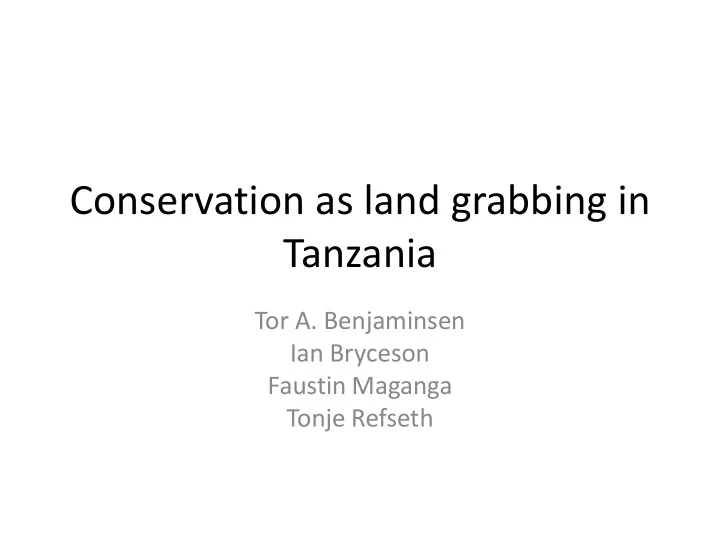

Conservation as land grabbing in Tanzania Tor A. Benjaminsen Ian Bryceson Faustin Maganga Tonje Refseth
Outline • Wildlife conservation • Forest conservation – CBFM in Tz as a model for REDD – Carbon plantations • Marine conservation
Wildlife conservation Wildlife tourism increasingly • important, 15 % annual growth in tourism during last few years 770 000 tourists in 2008 worth • USD 1,3 Billion, 33 % of GDP, safari tourism and trophy hunting Policy change from 1998 to 2007 • towards more state and less community Income from photo safaris has • been moved from village to central control Income from trophy hunting first • promised under local control, but still kept under government control WMAs: conservation introduced • on village land
Forest conservation • Tz considered to be a leader in CBFM (1440 villages, 2.2 mill ha) • Tz CBFM - a model for REDD implementation
Challenges in CBFM (Suledo case) • Suledo: 167,400 ha, 10 villages • 15 years of successful conservation • UNDP Equator Prize in 2002 • Potential annual revenue from timber of more than 200,000 USD • Promised harvesting but foot-dragging from central gvt and resistance from local gvt • Some harvesting started in 2010, but gvt still keeps control over charcoal • Influence of REDD?
Carbon plantations (case of Green Resources Ltd) Started mid 1990s, more than • 100,000 ha Sell credits on voluntary • market, Nor. Industry Land from 6 villages, leased for • 99 years GR has promised 10% of • carbon revenues to the villages, but not honored (no binding contract) Workers paid below minimum • wage Little support to community • projects
Marine conservation (case of Mafia Island Marine Park) Statements about community- • based conservation and co- management are largely rhetorical Villages are branded as being • uncooperative and troublesome Villagers feel they are losing land • and access rights to tourism enterprises Few locals get jobs in tourism • hotels, except the most menial Continued loss of access to fishing • grounds and beaches, increased restrictions on fishing gear More violent repressive practice in • the name of conservation during recent years
Conclusions • Wildlife & marine conservation: recentralisation, commodification • CBFM in Tz – a model? But also resistance from central and local government – implications for REDD? • Carbon forestry: loss of village land, some jobs, but generally little compensation (no commitments) • Commonalities: primitive accumulation (through biodiversity conservation, safari tourism and climate change mitigation)
Recommend
More recommend